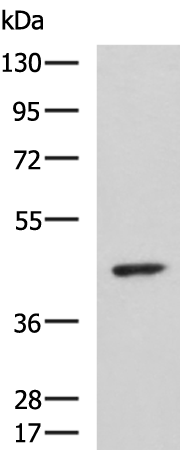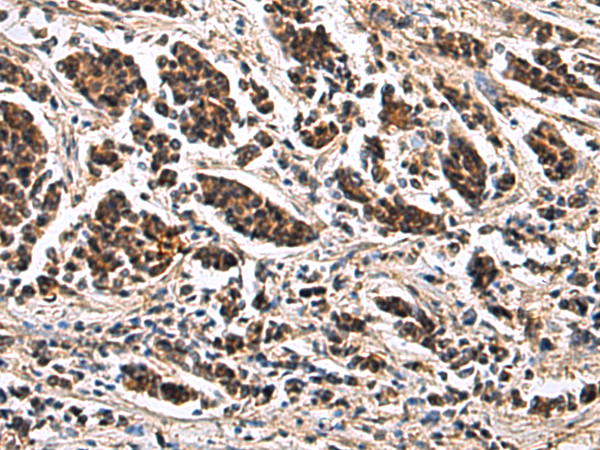

| WB | 咨询技术 | Human,Mouse,Rat |
| IF | 咨询技术 | Human,Mouse,Rat |
| IHC | 1/50-1/100 | Human,Mouse,Rat |
| ICC | 技术咨询 | Human,Mouse,Rat |
| FCM | 咨询技术 | Human,Mouse,Rat |
| Elisa | 1/5000-1/10000 | Human,Mouse,Rat |
| Aliases | ARC41; PLTEID; p40-ARC; p41-ARC |
| WB Predicted band size | 41 kDa |
| Host/Isotype | Rabbit IgG |
| Antibody Type | Primary antibody |
| Storage | Store at 4°C short term. Aliquot and store at -20°C long term. Avoid freeze/thaw cycles. |
| Species Reactivity | Human, Mouse, Rat |
| Immunogen | Fusion protein of human ARPC1B |
| Formulation | Purified antibody in PBS with 0.05% sodium azide and 50% glycerol. |
+ +
以下是关于ARPC1B抗体的3篇参考文献,涵盖其功能、疾病关联及实验应用:
1. **文献名称**:*ARPC1B deficiency leads to abnormal platelet activation and thrombosis*
**作者**:Kahr WHA, et al. (2017)
**摘要**:研究揭示了ARPC1B基因突变导致血小板形态异常和过度活化,通过ARPC1B抗体检测发现患者血小板中ARPC1B蛋白缺失,证实其与免疫缺陷及血栓风险的关联。
2. **文献名称**:*Human ARPC1B deficiency results in aberrant dendritic cell cytoskeletal dynamics*
**作者**:Volkman BF, et al. (2019)
**摘要**:利用ARPC1B抗体进行免疫印迹和免疫荧光分析,发现ARPC1B缺陷导致树突状细胞肌动蛋白重组障碍,影响细胞迁移和免疫突触形成。
3. **文献名称**:*ARPC1B mutation causes defective actin polymerization and thrombocytopenia*
**作者**:Kuijpers TW, et al. (2017)
**摘要**:通过患者样本分析,结合ARPC1B抗体的蛋白质检测,阐明ARPC1B突变损害肌动蛋白聚合,引发血小板减少症及复合型免疫缺陷表型。
4. **文献名称**:*ARPC1B controls T cell migration through regulation of actin dynamics*
**作者**:Randzavola LO, et al. (2019)
**摘要**:研究使用ARPC1B抗体进行流式细胞术和共聚焦成像,证实ARPC1B通过调控肌动蛋白细胞骨架动态,影响T细胞迁移和免疫应答功能。
这些文献均通过ARPC1B抗体在蛋白质水平探究其生物学功能及疾病机制,适用于实验设计或病理机制参考。
The ARPC1B antibody targets the Actin-Related Protein 2/3 Complex Subunit 1B (ARPC1B), a key component of the Arp2/3 complex, which regulates actin polymerization and cytoskeletal reorganization in eukaryotic cells. The Arp2/3 complex is essential for forming branched actin networks, a process critical for cell motility, membrane protrusion, and intracellular trafficking. ARPC1B, one of two isoforms (alongside ARPC1A), is predominantly expressed in hematopoietic cells and plays a specialized role in immune cell functions, including leukocyte migration and immunological synapse formation.
Antibodies against ARPC1B are widely used to study its expression, localization, and interactions in cellular processes. They are applied in techniques like Western blotting, immunofluorescence, and immunohistochemistry to investigate ARPC1B’s involvement in diseases linked to cytoskeletal dysregulation. For instance, ARPC1B deficiency is associated with platelet abnormalities, combined immunodeficiency, and autoimmune disorders, making its antibody a vital tool for diagnosing and researching these conditions.
Additionally, ARPC1B-specific antibodies help distinguish between ARPC1A and ARPC1B isoforms, which share ~65% amino acid identity but differ in tissue distribution and functional roles. Researchers use these antibodies to explore isoform-specific mechanisms in cancer metastasis, inflammation, and immune cell signaling. Validating antibody specificity is crucial, as cross-reactivity with ARPC1A may occur. Overall, ARPC1B antibodies are indispensable for dissecting cytoskeletal dynamics in both basic cell biology and clinical research contexts.
×